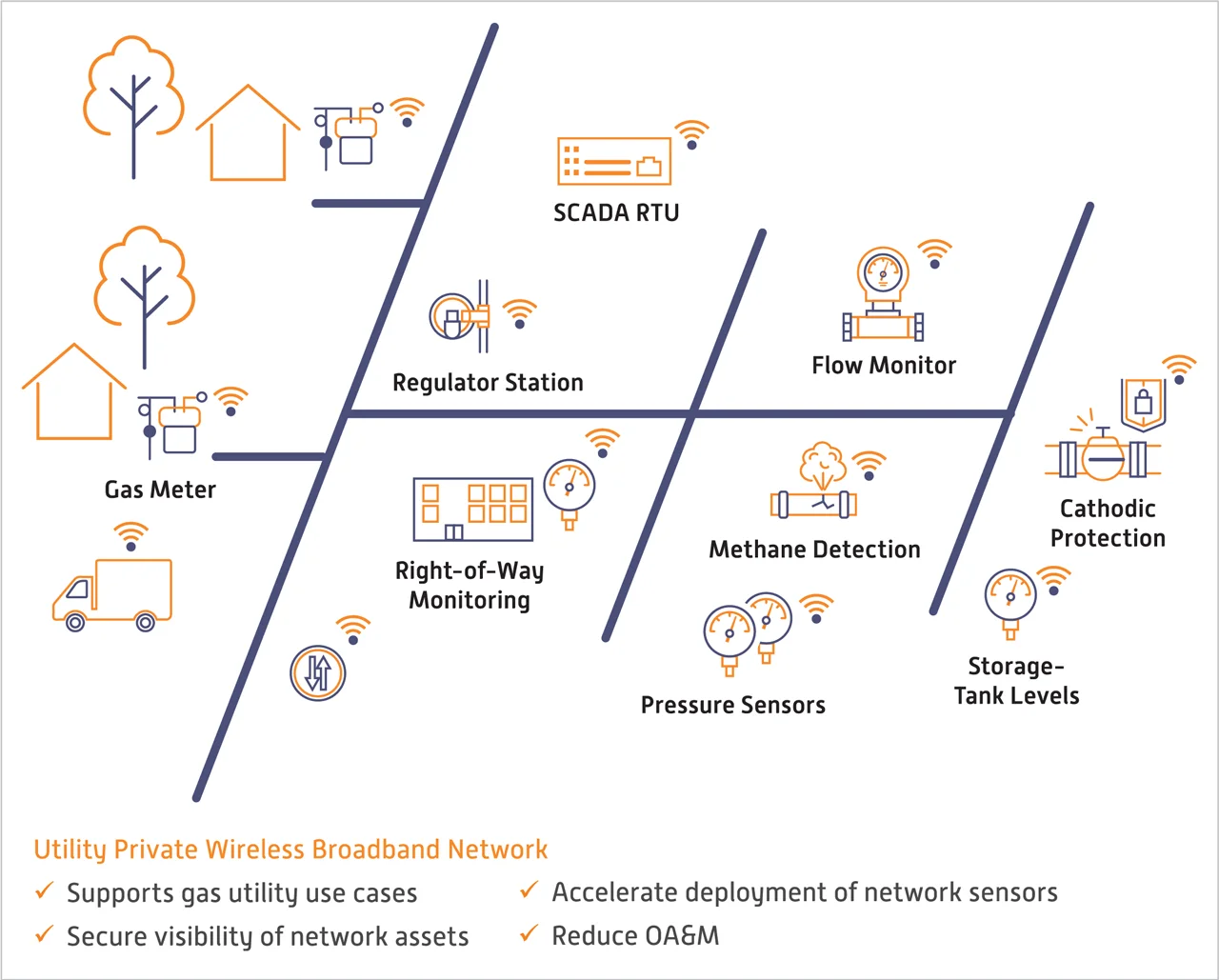American gas utilities operate networks with millions of miles of pipelines, requiring constant monitoring of pressure, flow, and levels to ensure safety and reliability. Real-time alerts and system-wide visibility supported by modern communications systems are essential for optimizing gas utility operations, detecting leaks early, providing safety, and improving efficiency. While utilities make every effort to maintain safety and prolong system longevity with signage and markers indicating buried infrastructure, when leaks or breaches arise, a rapid response is essential. Minimizing follow-up service visits, reducing inspection costs, and enabling safe, efficient meter assessments and repairs are key to optimizing gas operations.

Deploying robust and resilient communications networks by gas utilities enables early leak detection and proactive measures to maintain smooth gas distribution. Private wireless broadband networks utilizing 900 MHz can facilitate the rapid and cost-effective deployment of environmental sensors to monitor gas infrastructure, enabling remote operational control. Utilities can collect and analyze data real-time from sensors, equipment, and personnel, allowing operators to quickly detect and respond to critical events and anomalies. Gas utilities that use communications networks built on 900 MHz spectrum can benefit from the ability to cover large areas with fewer cell sites, optimizing both performance and cost- efficiency. Private broadband networks also support the evolution of gas meters to AMI 2.0 technologies, transforming meters into smart grid-edge sensors capable of running real-time applications to enhance efficiency and operational control.
As utility operations become increasingly complex and gas systems become more automated, private wireless broadband networks will provide the data speeds, capacity, security, technology, and analytics essential for supporting modern and resilient utility infrastructure.
Private Wireless Broadband Benefits for Gas Utilities:
Coverage and Resiliency: Provides coverage where it’s needed across wide and remote service territories. Enhances resiliency to keep communications operational even during power outages or other emergencies.
Safety: Helps enable safety through reliable, secure, low-latency transmission of mission- critical data like leak detection and equipment diagnostics.
Real-Time Control: Offers utilities real-time control over gas distribution, as well as the ability to support a multitude of automated technologies more effectively, including flow regulators, leak detection, and pipeline safety.
Enhanced Security: Includes built-in security features, with utilities implementing additional cybersecurity measures like identity authentication and access controls to strengthen network protection.
Asset Management: Provides reliable connectivity and management of critical assets, including gas sensors, voltage regulators, and distributed energy resources.

Additional Advantages of Private Wireless Broadband for Gas Utilities
Cost Efficiency: Reduces operational costs associated with traditional communication methods and improves overall efficiency.
Scalability: Easily scales to accommodate the growing needs of gas utilities, confirming that the network can handle increased data traffic and new applications.
Low Latency: Provides low-latency communication, which is essential for time-sensitive applications such as remote monitoring and control of gas pipelines.
Support for IoT Devices: Supports a wide range of Internet of Things (IoT) devices, enabling gas utilities to implement smart grid technologies and improve operational efficiency.
Spotlight: Anterix Active Ecosystem members
Some of the Anterix Active Ecosystem members offering solutions for gas utilities include:
Aclara: Aclara, a division of Hubbell Utility Solutions, provides smart infrastructure solutions that enhance utility operations through advanced metering infrastructure (AMI), edge devices, and robust software. Aclara’s technologies deliver a complete advanced metering, monitoring, and analytics solution set to some of the largest natural gas utilities.
Honeywell: Honeywell enhances utility operations with smart, data-driven solutions. They install, inspect, maintain, and upgrade electric, gas, and water systems, ensuring peak performance. Their smart meters provide real-time data insights, while asset management software enables intelligent connectivity at scale. Honeywell’s technologies help utilities reduce CO2 emissions, increase grid lifespan, and foster energy equity.
Itron: Itron is innovating the way utilities and cities manage energy and water. Their gas edge solutions integrate flexible, multiple data transport methods networked with ultrasonic metering, sensors, and advanced applications. By pushing intelligence to the network edge, they significantly enhance safety, enable better decision-making, and improve operational efficiency.
Landis+Gyr: Landis+Gyr is a leading global provider of integrated energy management solutions that measure and analyze energy utilization to generate empowering analytics for smart grid and infrastructure management. Landis+Gyr’s all-in-one G480 Ultrasonic Smart Gas Meter delivers advanced smart technology solutions in a compact, flexible, and proven meter, based on 30 years of global leadership experience and installation of more than 16 million smart gas endpoints.
Anterix Active Ecosystem Solution Overviews
Browse the Anterix Active Ecosystem Solution Overviews library, a collection of informational overviews designed to deepen your understanding of pivotal topics in the utility industry.
Stay informed and ahead of the curve - explore the rest of our Solution Overviews handouts today!

